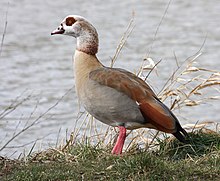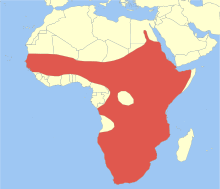Egyptian goose
| Egyptian goose | |
|---|---|
 |
|
|
Calls recorded in the Masai Mara Game Reserve, Kenya
|
|
| Scientific classification | |
| Kingdom: | Animalia |
| Phylum: | Chordata |
| Class: | Aves |
| Order: | Anseriformes |
| Family: | Anatidae |
| Subfamily: | Tadorninae |
| Genus: | Alopochen |
| Species: | A. aegyptiacus |
| Binomial name | |
|
Alopochen aegyptiacus (Linnaeus, 1766) |
|
 |
|
| Native range of A. aegyptiacus | |
| Synonyms | |
|
Alopochen aegyptiaca (Linnaeus, 1766) |
|
Alopochen aegyptiaca (Linnaeus, 1766)
The Egyptian goose (Alopochen aegyptiacus) is a member of the duck, goose, and swan family Anatidae. It is native to Africa south of the Sahara and the Nile Valley.
Egyptian geese were considered sacred by the Ancient Egyptians, and appeared in much of their artwork. They have been raised for food and extensively bred in parts of Africa since they were domesticated by the ancient Egyptians. Because of their popularity chiefly as ornamental bird, escapes are common and small feral populations have become established in Western Europe.
The Egyptian goose is believed to be most closely related to the shelducks (genus Tadorna) and their relatives, and is placed with them in the subfamily Tadorninae. It is the only extant member of the genus Alopochen, which also contains closely related prehistoric and recently extinct species. mtDNA sequence data suggest that the relationships of Alopochen to Tadorna need further investigation.
The generic name is based on Greek ἀλώπηξ (alōpēx), "fox", and χήν (chēn) "goose", referring to the ruddy colour of its back. The species name aegyptius is from the Latin Aegyptius, "Egyptian".
It swims well, and in flight looks heavy, more like a goose than a duck, hence the English name. It is 63–73 cm (25–29 in) long.
The sexes of this species are identical in plumage but the males average slightly larger. There is a fair amount of variation in plumage tone, with some birds greyer and others browner, but this is not sex- or age-related. A large part of the wings of mature birds is white, but in response the white is hidden by the wing coverts. When it is aroused, either in alarm or aggression, the white begins to show. In flight or when the wings are fully spread in aggression, the white is conspicuous.
...
Wikipedia

